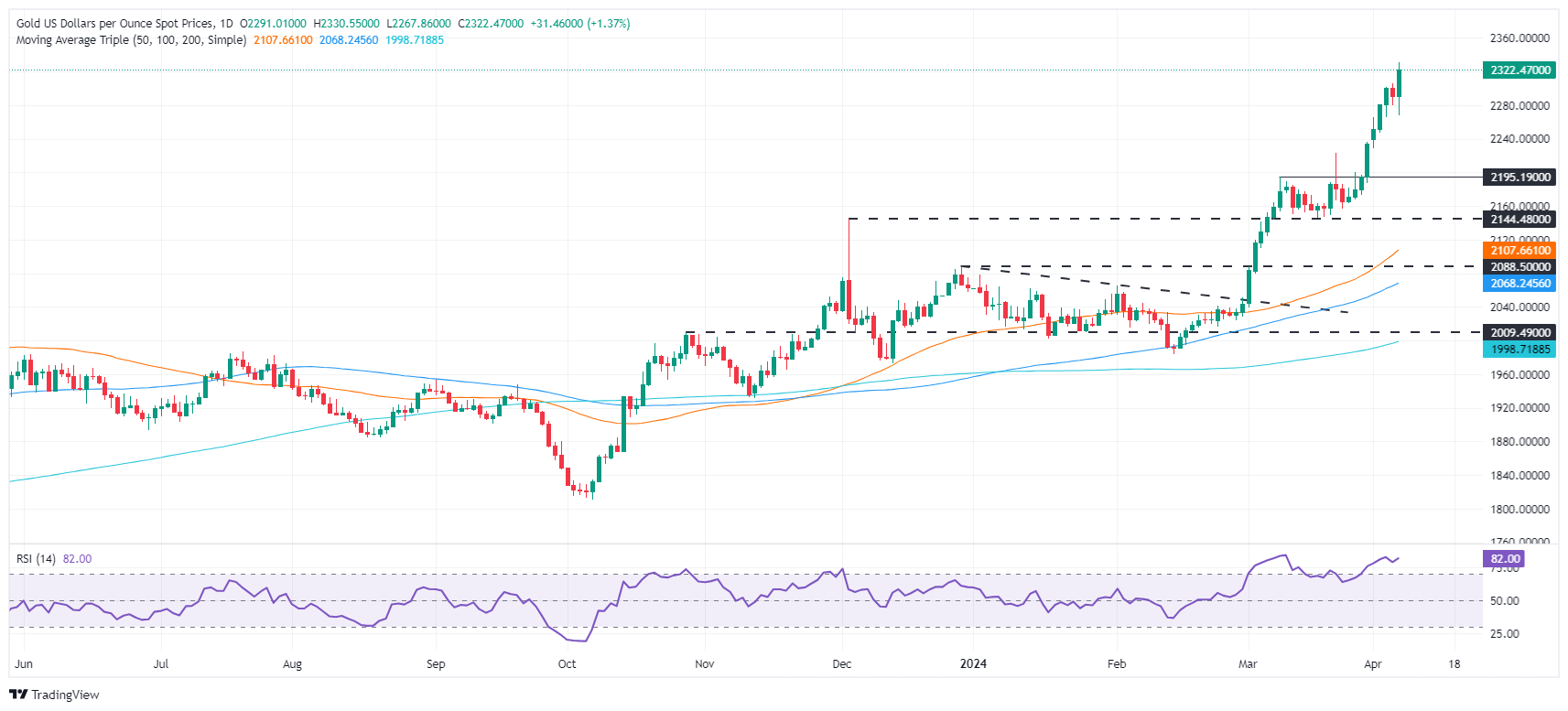- Gold hits all-time highs, defying the rally in US Non-Farm Payrolls and gains in the US Dollar, highlighting its safe-haven status.
- Adjustment of Fed rate cut outlook following employment data and central bank comments.
- Geopolitical tensions and strong demand from China reinforce Gold's strength.
Gold hit a new all-time high, ignoring the strong March Non-Farm Payrolls report in the United States (US), which could prevent the Federal Reserve (Fed) from cutting rates sooner than the market expects. In achieving its milestone, the yellow metal ignored the rise in US Treasury yields and the Dollar, which is clinging to a modest 0.09% gains.
XAU/USD is trading at $2,324, after reaching $2,330 in the North American session on Friday. The price of Gold continued to be driven by fundamentals linked to the US dollar, geopolitical risks and physical demand.
Focusing on the data, March US Nonfarm Payrolls numbers beat estimates and February numbers as new hiring increased to 303,000 jobs. Consequently, the unemployment rate fell, while average hourly earnings were uneven, rising in monthly figures but falling in annual terms.
Following the data, bets that the Fed would cut rates in June fell further, from around 70% a week ago to 53.4%, according to CME's FedWatch tool.
The jobs report reinforced Fed Chairman Jerome Powell's words on Wednesday. He said they are in no rush to cut rates, and his words resonated throughout the week. On Friday, officials crossed the wires led by the Richmond Fed's Barkin, the Dallas Fed's Logan, and Governor Bowman.
Daily Market Summary: Gold Relies on Strong Physical Demand, Ignores US Data
- The US Department of Labor announces that Non-Farm Payrolls increased by 303,000 in March, above the 200,000 expected and the previous 270,000.
- Other data revealed that the unemployment rate declined modestly to 3.8% from 3.9%, and that average hourly earnings met consensus forecasts. Average hourly earnings increased 0.3% month-over-month, up from 0.2% previously. In the twelve months to March, profits rose 4.1%, as expected, versus 4.3%.
- Following these figures, the US dollar strengthened, as evidenced by the 0.15% rise in the US Dollar Index (DXY), which stood at 104.36 points. US Treasury yields rose about 5 basis points, with the 10-year rate hitting 4.365%.
- Recently, Fed Governor Michelle Bowman stated that cutting rates too soon risks a rebound in inflation. She said the bank would eventually lower rates, although inflationary risks lean to the upside. Earlier, Richmond Fed President Thomas Barkin called the NFP report strong, but noted that the reduction in inflation has been inconsistent.
- Dallas Fed President Lorie Logan said there is “no urgency” in cutting borrowing costs, adding that the risk of cutting too soon is greater than the risk of cutting too late.
- Geopolitical risks loom after Israel's attack on Iran's embassy in Syria. Iran vowed to retaliate against Israel after the deaths of seven officers. A further rally could put upward pressure on gold prices, with traders targeting $2,350.
- The World Gold Pool reveals that the People's Bank of China was the largest buyer of the yellow metal, increasing its reserves by 12 tons to 2,257 tons.
Technical Analysis: Gold will continue to rise despite overbought RSI

Gold's rise is set to continue, with buyers gaining momentum. The Relative Strength Index (RSI), although in overbought conditions beyond the 70.00 level, is pointing north. Typically, when an asset is in a strong uptrend, the reading of 80 is considered the extreme of overbought. However, with the price action showing no signs of exhaustion, the $2,350 level remains key.
On the other hand, the first support level would be $2,300. Breaking this last level would expose $2,250, followed by $2,200.
Frequently asked questions about Gold
Gold has played a key role in human history as it has been widely used as a store of value and medium of exchange. Today, aside from its brilliance and use for jewelry, the precious metal is considered a safe-haven asset, meaning it is considered a good investment in turbulent times. Gold is also considered a hedge against inflation and currency depreciation, as it is not dependent on any issuer or government.
Central banks are the largest holders of Gold. In their aim to support their currencies in turbulent times, central banks tend to diversify their reserves and purchase Gold to improve the perception of strength of the economy and currency. High Gold reserves can be a source of confidence for the solvency of a country. Central banks added 1,136 tons of gold worth about $70 billion to their reserves in 2022, according to data from the World Gold Council. This is the largest annual purchase since records exist. Central banks in emerging economies such as China, India and Türkiye are rapidly increasing their gold reserves.
Gold has an inverse correlation with the US Dollar and US Treasuries, which are the main reserve and safe haven assets. When the Dollar depreciates, Gold tends to rise, allowing investors and central banks to diversify their assets in turbulent times. Gold is also inversely correlated with risk assets. A rally in the stock market tends to weaken the price of Gold, while sell-offs in riskier markets tend to favor the precious metal.
The price can move due to a wide range of factors. Geopolitical instability or fear of a deep recession can cause the price of Gold to rise rapidly due to its status as a safe haven asset. Being a non-yielding asset, Gold tends to rise with lower interest rates, while the higher cost of money usually weighs on the yellow metal. However, most of the movements depend on the behavior of the US Dollar (USD), as the asset is traded in dollars (XAU/USD). A strong Dollar tends to keep the price of Gold in check, while a weaker Dollar is likely to push up Gold prices.
Source: Fx Street
I am Joshua Winder, a senior-level journalist and editor at World Stock Market. I specialize in covering news related to the stock market and economic trends. With more than 8 years of experience in this field, I have become an expert in financial reporting.







